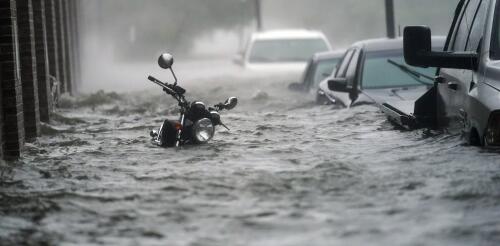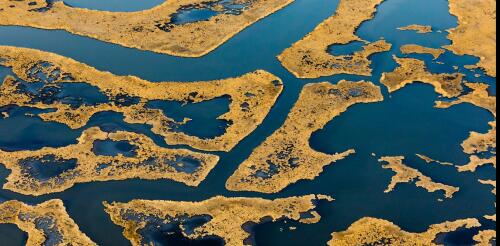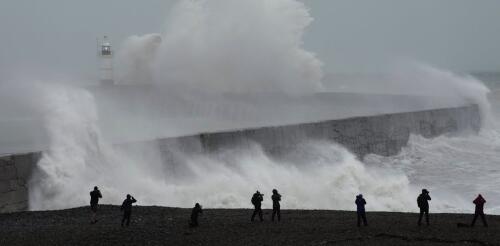Sea level rise
As we focused our microscope on the soil sample for the first time, bits of organic material came into view: a tiny poppy seed, the compound eye of an insect, broken willow twigs and spikemoss spores. Dark-colored spheres produced by soil fungi dominated our view. These were unmistakably the remains of an arctic tundra ecosystem – and proof that Greenland’s entire ice sheet disappeared more recently than people realize. These tiny hints of past life came from a most unlikely place – a handful of soil that had been buried under 2 miles of ice below the summit of the Greenland ice sheet. Projections of future melting of the ice sheet are unambiguous: When the ice is gone at the summit, at least 90% of Greenland’s ice will have melted. Results of an ice sheet model show how much of Greenland’s ice sheet survives when the ice is gone from the Camp Century (white dot), GISP2 (red dot) and DYE-3 (black dot) ice...
Antarctica’s Thwaites Glacier got its nickname the “Doomsday Glacier” for its potential to flood coastlines around the world if it collapsed. It is already contributing about 4% of annual sea-level rise as it loses ice, and one theory suggests the glacier could soon begin to collapse into the ocean like a row of dominoes. But is that kind of rapid collapse really as likely as feared? A new study of Thwaites Glacier’s susceptibility to what’s known as marine ice cliff instability offers some hope. But the findings don’t mean Thwaites is stable. Polar scientist Mathieu Morlighem, who led the study, explains the results. Why is the Thwaites Glacier so important? Thwaites Glacier drains a huge area of Antarctica’s ice sheet – about 74,000 square miles (192,000 square kilometers), an expanse bigger than Florida. If a snowflake falls within that drainage system, it will eventually end up as part of an iceberg in the ocean off Thwaites....
Ocean-related tourism and recreation supports more than 320,000 jobs and US$13.5 billion in goods and services in Florida. But a swim in the ocean became much less attractive in the summer of 2023, when the water temperatures off Miami reached as high as 101 degrees Fahrenheit (37.8 Celsius). The future of some jobs and businesses across the ocean economy have also become less secure as the ocean warms and damage from storms, sea-level rise and marine heat waves increases. Ocean temperatures have been heating up over the past century, and hitting record highs for much of the past year, driven primarily by the rise in greenhouse gas emissions from burning fossil fuels. Scientists estimate that more than 90% of the excess heat produced by human activities has been taken up by the ocean. That warming, hidden for years in data of interest only to oceanographers, is now having profound consequences for coastal economies around the world. Understanding the role of the ocean in th...
Wetlands have flourished along the world’s coastlines for thousands of years, playing valuable roles in the lives of people and wildlife. They protect the land from storm surge, stop seawater from contaminating drinking water supplies, and create habitat for birds, fish and threatened species. Much of that may be gone in a matter of decades. As the planet warms, sea level rises at an ever-faster rate. Wetlands have generally kept pace by building upward and creeping inland a few meters per year. But raised roadbeds, cities, farms and increasing land elevation can leave wetlands with nowhere to go. Sea-level rise projections for midcentury suggest the waterline will be shifting 15 to 100 times faster than wetland migration has been clocked. Many wetlands, like these on Cape Cod, are now bordered by human infrastructure, including towns and roads. Lance Cheung/USDA I have been studying coastal g...
As oceans waves rise and fall, they apply forces to the sea floor below and generate seismic waves. These seismic waves are so powerful and widespread that they show up as a steady thrum on seismographs, the same instruments used to monitor and study earthquakes. That wave signal has been getting more intense in recent decades, reflecting increasingly stormy seas and higher ocean swell. In a new study in the journal Nature Communications, colleagues and I tracked that increase around the world over the past four decades. These global data, along with other ocean, satellite and regional seismic studies, show a decadeslong increase in wave energy that coincides with increasing storminess attributed to rising global temperatures. What seismology has to do with ocean waves Global seismographic networks are best known for monitoring and studying earthquakes and for allowing scientists to create images of the planet’s deep interior. These highly sensitive instruments continu...




